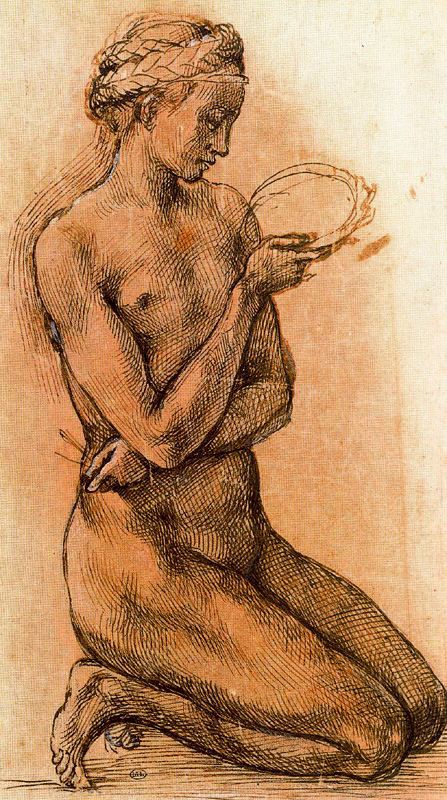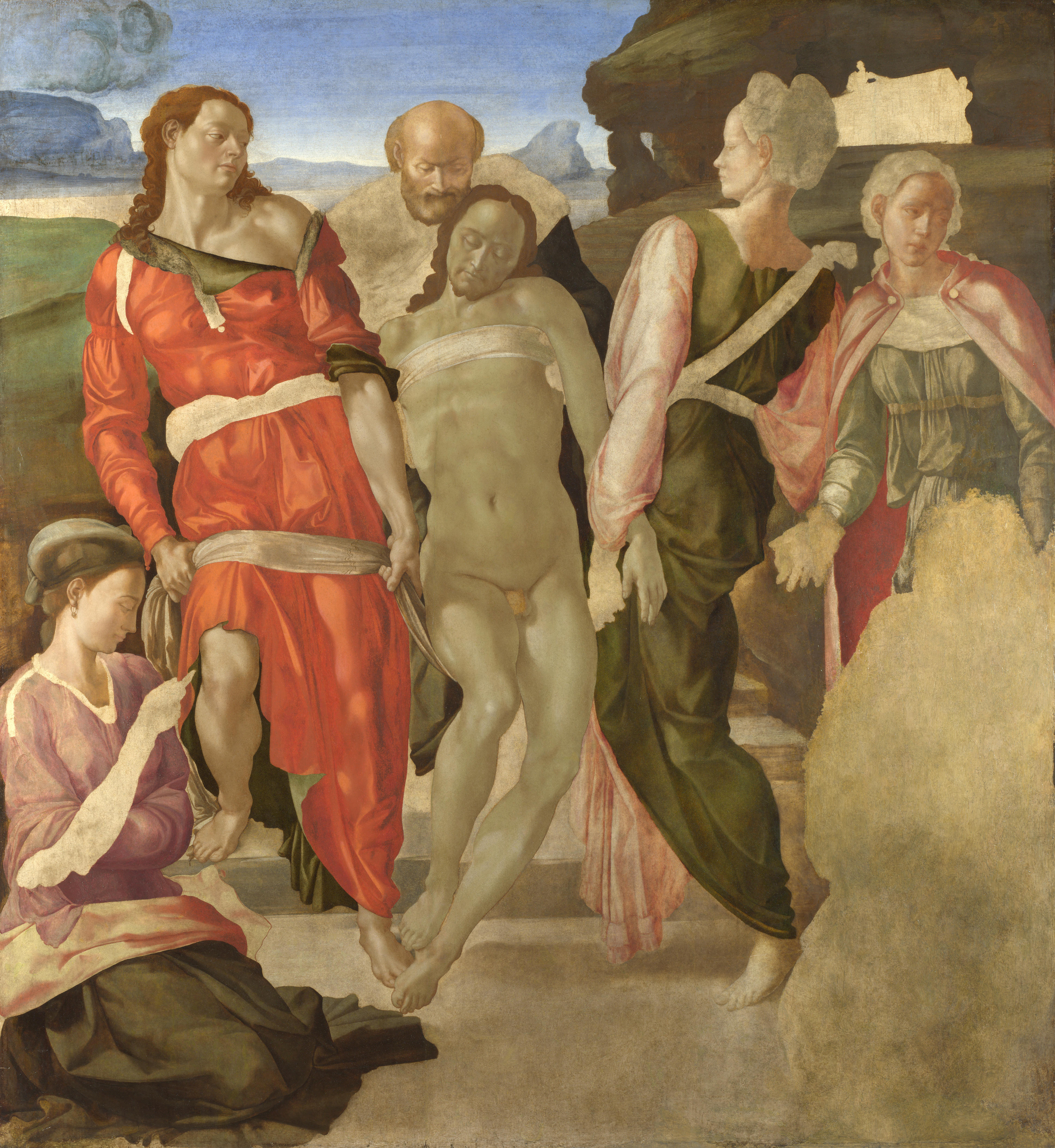Study Of A Kneeling Nude Girl For The Entombment on:
[Wikipedia]
[Google]
[Amazon]
 ''Study of a Kneeling Nude Girl for The Entombment'' is a drawing of c. 1500–1501 by
''Study of a Kneeling Nude Girl for The Entombment'' is a drawing of c. 1500–1501 by 
Chapman, Hugo. ''Michelangelo drawings: closer to the master'', 2005. New Haven, Yale University Press.
Dunkerton, Jill, et al. ''Dürer to Veronese: Sixteenth-Century Painting in the National Gallery'', 1999. New Haven and London, Yale University Press.
Hirst, Michael. ''Michelangelo and his drawings'', 1996. Yale University Press.
{{Michelangelo, more Drawings by Michelangelo 1500s drawings Drawings of the Louvre Nude art Depictions of kneeling
 ''Study of a Kneeling Nude Girl for The Entombment'' is a drawing of c. 1500–1501 by
''Study of a Kneeling Nude Girl for The Entombment'' is a drawing of c. 1500–1501 by Michelangelo
Michelangelo di Lodovico Buonarroti Simoni (; 6 March 1475 – 18 February 1564), known as Michelangelo (), was an Italian sculptor, painter, architect, and poet of the High Renaissance. Born in the Republic of Florence, his work was ins ...
, now in the Louvre Museum
The Louvre ( ), or the Louvre Museum ( ), is the world's most-visited museum, and an historic landmark in Paris, France. It is the home of some of the best-known works of art, including the ''Mona Lisa'' and the ''Venus de Milo''. A central l ...
. It is in black chalk, with pen and ink and white highlighting, on pink prepared (coloured) paper, and measures 26.6 cm x 15.1 cm. It is a figure study
A figure study is a drawing or painting of the human body made in preparation for a more composed or finished work; or to learn drawing and painting techniques in general and the human figure in particular. By preference, figure studies are done f ...
made in preparation for his painting ''The Entombment
The burial of Jesus refers to the entombment of the body of Jesus after crucifixion, before the eve of the sabbath described in the New Testament. According to the canonical gospel narratives, he was placed in a tomb by a councillor of the san ...
'', and is Michelangelo's only surviving study that was probably drawn from a nude female model.Dunkerton, et al, 186 It also may be the earliest extant European drawing of a nude female model.Dunkerton, et al, 186
The figure in the drawing relates to a woman seated in the lower left foreground of the painting. Included in the study are narrative details such as the nails of the cross, held in her left hand, and the crown of thorns in her right. Although the drawing's attribution has been doubted, it is now accepted as authentic.Dunkerton, et al, 186Hirst, 63 The elaboration of the plaited hair suggests that the drawing was made from life using a young girl as the model.Hirst, 63 The drawing was made in three stages: first it was lightly laid down in black chalk, then gone over with pen and light bistre, and finally drawn over completely with a finer pen and darker ink.Hirst, 64 Lateral strokes were placed at the bottom to indicate the ground plane, and touches of white body color were added to details of the figure. Rare for a drawing by Michelangelo is the pink ground,Hirst, 64 in this case achieved by rubbing crushed red chalk onto the paper.Chapman, 20
Because the use of nude female models was controversial, relatively few such drawings were made before the 17th century, when academic life classes were established.Dunkerton, et al, 186 Before that boys or young men, typically studio apprentices, were used as models for figures of both sexes, as is sometimes rather apparent. Exceptions from the Italian Renaissance
The Italian Renaissance ( it, Rinascimento ) was a period in Italian history covering the 15th and 16th centuries. The period is known for the initial development of the broader Renaissance culture that spread across Europe and marked the trans ...
include Raphael
Raffaello Sanzio da Urbino, better known as Raphael (; or ; March 28 or April 6, 1483April 6, 1520), was an Italian painter and architect of the High Renaissance. His work is admired for its clarity of form, ease of composition, and visual ...
, who made nude drawings, apparently of his mistress, and Lorenzo Lotto
Lorenzo Lotto (c. 1480 – 1556/57) was an Italian painter, draughtsman, and illustrator, traditionally placed in the Venetian school, though much of his career was spent in other north Italian cities. He painted mainly altarpieces, religiou ...
, who recorded in his account book having used women of ill repute as life models.Dunkerton, et al, 186 In Florence
Florence ( ; it, Firenze ) is a city in Central Italy and the capital city of the Tuscany region. It is the most populated city in Tuscany, with 383,083 inhabitants in 2016, and over 1,520,000 in its metropolitan area.Bilancio demografico ...
, Michelangelo and Raphael initiated the practice of making preparatory studies of the nude prior to painting the figure fully clothed, in order to better understand the underlying structure of the body.Dunkerton, et al, 186

References
External links
Chapman, Hugo. ''Michelangelo drawings: closer to the master'', 2005. New Haven, Yale University Press.
Dunkerton, Jill, et al. ''Dürer to Veronese: Sixteenth-Century Painting in the National Gallery'', 1999. New Haven and London, Yale University Press.
Hirst, Michael. ''Michelangelo and his drawings'', 1996. Yale University Press.
{{Michelangelo, more Drawings by Michelangelo 1500s drawings Drawings of the Louvre Nude art Depictions of kneeling